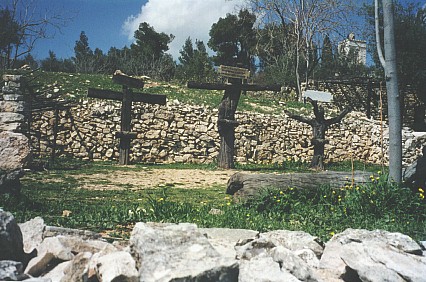Personal Update, July 1995
Yots and Tittles:
Jesus' Epitaph
By Chuck Missler
Koinonia House Ministries
Throughout the Tanach--our Old Testament--there
are many fascinating acrostics and other textual peculiarities
that will fascinate the diligent scholar. In the New Testament
there also appears to be a Hebrew acrostic that generally goes
unnoticed.
When Jesus was crucified, Pilate wrote the
sign that was nailed to the cross. The particular wording he chose
displeased the Jewish leadership and they asked him to change
it. He refused. There are some interesting aspects to this incident
that are not apparent in our English translations.
And Pilate wrote a title, and put [it]
on the cross. And the writing was, Jesus Of Nazareth The King
Of The Jews.
This title then read many of the Jews:
for the place where Jesus was crucified was nigh to the city:
and it was written in Hebrew, [and] Greek, [and] Latin.
Then said the chief priests of the Jews
to Pilate, Write not, The King of the Jews; but that he said,
I am King of the Jews.
Pilate answered, What I have written
I have written. (John 19:19-22)

Pilate refused to revise the epitaph he had
composed. This may have more significance than is apparent in
our English translations. The Hebrew is shown below (remember,
it goes from right to left):
 Yeshua HaNazarei v Melech
Yeshua HaNazarei v Melech
HaYehudim: Jesus the Nazarei
and King of the Jews.
What we don't notice in the English translation
is that the acrostic made up of the first letter of each word
spells out Yahweh (YHWH)!
If Pilate had rewritten it in the manner they
had requested him to, it would not have spelled out the Name of
God. Did Pilate realize this? Was it deliberate? Did he do it
just to upset the Jewish leadership, which he realized delivered
Him up for envy? (Matthew 27:18). Or was he beginning to suspect
that there was more going on here than he previously realized?
When they requested a special guard for the
tomb, he also responded with a enigmatic remark,
"Make it as sure as you can." (Matthew 27:63-66)
What did he mean by that? Did he begin to suspect
that Jesus really was who said He was? Was Pilate really surprised
when Jesus was resurrected after three days? One wonders.
Other Acrostics
There is a similar occurrence in the Book of
Leviticus. After the first  count seven letters, and you find a
count seven letters, and you find a
 count
seven more letters and you find a
count
seven more letters and you find a  then seven more and you
find another
then seven more and you
find another  again spelling the YHWH, the Name of God. See below.
again spelling the YHWH, the Name of God. See below.

Even more remarkable is that in the five books
of Moses the Torah  appears in letter intervals in both
the Books of Genesis and Exodus (see Figure 1). In the Books
of Numbers and Deuteronomy, in
appears in letter intervals in both
the Books of Genesis and Exodus (see Figure 1). In the Books
of Numbers and Deuteronomy, in  letter intervals, we again find the
"Torah," but spelled backwards! (See Figure 2).
letter intervals, we again find the
"Torah," but spelled backwards! (See Figure 2).
 It would seem the "Torah"
always points to the Name of God ("YHWH")!
See Figure 3. Many of the secrets hidden
behind the text have yet to be discovered.
It would seem the "Torah"
always points to the Name of God ("YHWH")!
See Figure 3. Many of the secrets hidden
behind the text have yet to be discovered.

Back to Lambert Dolphin's Library




